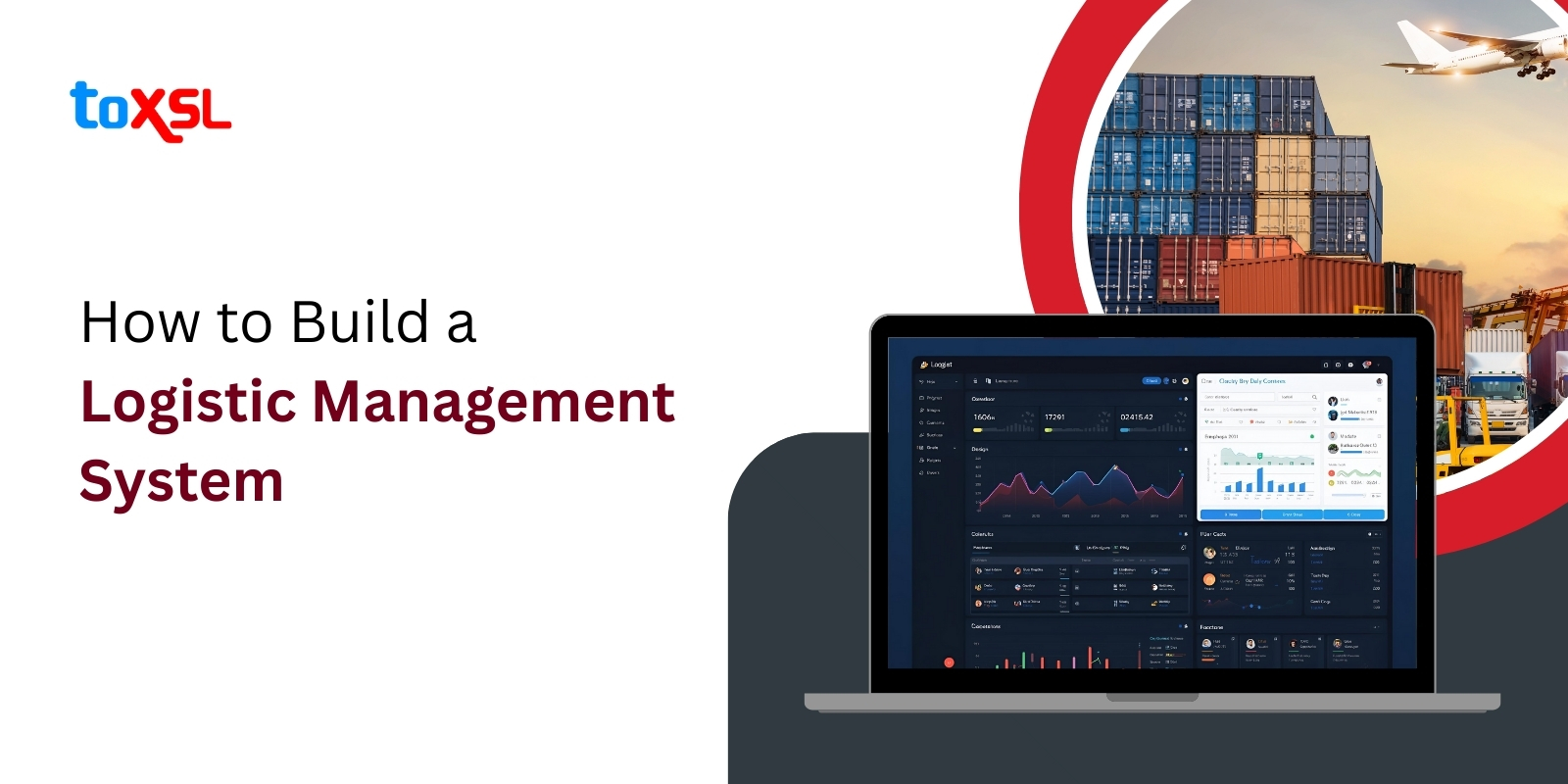- Dec 11, 2025
Share this post on:

According to a study, the global logistics market is expected to reach $42.36 billion by 2034, growing at a CAGR of 9.1%. A logistics management system manages and optimizes complex supply chain activities. The main focus of the market is on software solutions that help with warehouse operations, transportation planning, and inventory control across the logistics ecosystem.
Logistic management system refers to acquiring, storing, and transporting inventory from its original place to its destination in the best and easiest way possible. LMS is a software tool that optimizes forward and reverse logistics operations in a digital environment. Forward logistics handles order processing, inventory checking, packing, picking, and dispatching transportation routines for timely customer delivery. However, reverse logistics manages incorrect or damaged shipments, repairing and reusing them.
Key Takeaway:
A Logistic Management System automates logistics to boost supply chain efficiency.
Developing an LMS involves planning, designing, building, testing, and training.
Key modules include order, inventory, and warehouse management.
LMS benefits include cost savings, better customer service, and scalability.
Costs vary based on features, from custom builds to cloud-based solutions.
What are the Benefits of a Logistics Management System?
The success of your business highly depends on your ability to manage business operations effectively. As your business scales, one of the biggest challenges that you can face is managing the operations. However, using a Logistics Management System can help you manage your business effectively. But how? In this section, we are going to discover how a Logistics Management System can help you streamline your business.
Automation and Inventory Control: Automation can help businesses handle multiple processes, including label printing and carrier allocation, helping you eliminate manual effort and save time. Also, we are living in an era of Artificial Intelligence, where businesses can easily make informed decisions by integrating AI solutions in their operations. Further, businesses can reduce errors by setting up pre-set rules for assigning orders to carriers.
Balanced Operational Costs: One of the best advantages of investing in logistics management software is the reduction in operational expenses. LMS software helps businesses streamline their operations and handle other parts effectively, including inventory control, warehousing, material handling, and storage. Advanced logistics management systems give optimized routes to destinations by reducing operational costs. Pairing LMS with hardware inventory management software can further improve tracking, reduce equipment losses, and ensure resources are used efficiently.
Increased Productivity: Logistics management is a complex process that is often surrounded by numerous challenges. However, the LMS system removes the complexity and enhances the productivity of your business. These systems help businesses reduce the wastage of resources and maintain the quality standards of your business, increasing the efficiency and productivity of your business.
Enhanced Customer Experience: The entire process of logistic management consists of numerous activities, including safe packaging, warehousing, and other operations, to develop a seamless and great user experience. The logistics management system automates numerous activities that speed up the process and increases customer experience. And the best part? The system also offers data analytics that help companies get useful insights to meet customer needs.
Route Optimization: Route optimization comes into play if you are managing internal delivery agents. This helps you ensure drivers take the best route and reach their destinations on time, increasing customer satisfaction. Efficient routes also come with the benefits of not requiring high maintenance and reducing extra wages for overtime. This saves money, so you can spend more on growing your business.
Steps to Build a Logistics Management System
Now that we have discussed the benefits that an LMS system can offer. But how do you develop a Logistics Management System? It seems to be delivering a lot of benefits to your business, but it can be a challenging process to develop a scalable, secure, and efficient Logistics Management System. Let us now discuss the steps to build a Logistics Management System:
Define What You Need: First, clearly decide what your logistics system must do. Think about the tasks such as tracking orders, managing inventory, planning delivery routes, and keeping real-time updates. Also, set a budget and timeline to finish the system.
Plan the System Design: Next, design how the system will work. Divide it into parts like order handling, inventory control, warehouse management, and transport planning. Pick the right hardware and software needed and plan how all parts will connect and communicate.
Build and Test the System: Now, it's time to make the system. Start coding and putting everything together. After building, test the system carefully to find and fix any problems. Tests should include checking normal work, busy times, and possible errors. Let some users try it out and give feedback.
Launch and Monitor: Finally, put the system into real use. Keep watching how it performs using data to see if it meets goals. Fix problems that come up quickly and keep making the system better. Also, check that it is safe and follows the rules.
How Much Does it Cost to Develop a Logistics Management System?
The cost of developing a logistics management system can vary widely depending on several factors. These include the features you want, the complexity of the system, the platforms (mobile, web) you need, and whether you want advanced options like real-time tracking, route optimization, AI, or integrations with other software.
A basic system with simple features such as order tracking and route planning may cost around $25,000 to $50,000, suitable for small businesses. Medium-level systems with more functions like inventory management and order processing, can range from $50,000 to $150,000. Large, fully customized enterprise systems with complex workflows and many integrations can cost $150,000 or more. Other cost factors include the technology used, team location, maintenance needs, and scalability plans. Post-launch maintenance generally adds 10-25% of the initial development cost annually.
System Type | Estimated Cost Range | Timeline | Key Features |
|---|
Basic/Small Business System | $25,000 - $50,000 | 3-4 months | GPS tracking, route planning, basic reporting |
Medium/ Warehouse Management | $50,000 - $150,000 | 4-8 months | Inventory management, order processing, integrations |
Enterprise Complex System | $150,000 - $500,000+ | 8-18 months | Full features, custom workflows, complex integrations |
Additionally, here is a breakdown of costs related to development stages for a simple, moderate, and advanced logistics app:
Development Stage | Simple App Cost | Moderate App Cost | Advanced App Cost |
|---|---|---|---|
Planning and Research | $3,000 - $7,000 | $5,000 - $10,000 | $7,000 - $15,000 |
Design and Prototyping | $5,000 - $10,000 | $10,000 - $20,000 | $15,000 - $30,000 |
Frontend & Backend Dev | $15,000 - $30,000 | $30,000 - $60,000 | $50,000 - $100,000 |
Integration and Testing | $7,000 - $15,000 | $15,000 - $30,000 | $25,000 - $50,000 |
Deployment and Launch | $3,000 - $7,000 | $5,000 - $10,000 | $7,000 - $15,000 |
Post-Launch Maintenance | 10-15% of dev cost | 15-20% of dev cost | 20-25% of dev cost |
Total Estimated Cost:
Simple App: $33,000 - $69,000
Moderate App: $65,000 - $130,000
Advanced App: $104,000 - $215,000
What are the main Modules of Logistic Management Systems?
In this section, we will focus on the main modules of logistic management systems. You can choose the modules that you would like to add to your LMS system:
1. Order Management
Handles everything related to customer orders from start to finish. Ensures accurate processing, real-time tracking, and smooth returns or cancellations.
- Tracks orders from placement to final delivery.
- Processes payments and assigns orders to the right warehouse.
- Manages returns and cancellations efficiently.
- Sends real-time updates to keep customers informed.
- Automates tasks to save time and reduce errors.
2. Inventory Management
Provides real-time visibility of stock across warehouses and channels. Prevents shortages, overstocking, and overselling with timely alerts and tracking.
Monitors stock levels in real time.
Sends alerts for restocking and low inventory.
Supports accurate demand forecasting and purchase planning.
Manages storage costs effectively.
Prevents delays in order fulfillment.
3. Warehouse Management
Streamlines warehouse operations for faster, more accurate order fulfillment. Ensures optimized use of space, efficient picking, and reduced shipping errors.
Organizes product storage, picking, packing, and dispatch.
Tracks inventory within the warehouse in real time.
Guides staff on correct items to pick for delivery.
Improves space utilization and efficiency.
Reduces mistakes and delays in shipping.
4. Labor Management
Manages workforce allocation, performance, and productivity. Ensures proper staffing during peak hours while cutting down overtime and costs.
Schedules shifts and allocates staff effectively.
Tracks performance and monitors productivity.
Ensures optimal staffing during busy periods.
Reduces overtime costs and labor inefficiencies.
Improves efficiency in order handling and shipping.
Conclusion:
A well-designed logistics management System is a vital tool for businesses looking to optimize their logistics and supply chain operations. It not only increases operational efficiency but also enhances transparency and customer experience throughout the delivery process.
At ToXSL Technologies, we understand that building a robust Logistics Management System can enhance your business’ driving efficiency and elevate customer satisfaction. With our deep expertise in custom Logistic software development and supply chain solutions, we are committed to offering the best logistics solutions to our clients. Want to know how? Contact us today, and let's discuss how ToXSL can help your business grow with our Logistics Management System.
FAQS
How long does it take to build a Logistics Management System?
Basic LMS: 3–4 months
Medium LMS: 4–8 months
Enterprise LMS: 8–18 months
Timelines depend on features, integrations, and testing requirements.
What technologies are used to build an LMS?
An LMS is typically built using web and mobile frameworks, cloud hosting, APIs for integration, AI for decision-making, GPS for tracking, and secure databases for handling large volumes of supply chain data.
Can LMS integrate with existing business systems (ERP, CRM, accounting tools)?
Yes. A custom-built LMS can be integrated with ERP systems, CRM platforms, payment gateways, and accounting tools to ensure seamless operations across all departments.
How does an LMS improve customer experience?
By automating order processing, providing real-time tracking, reducing delivery delays, and offering smooth return handling, an LMS ensures transparency and reliability, resulting in better customer satisfaction.
Is a Logistics Management System scalable for business growth?
Absolutely. A well-designed LMS grows with your business by handling more orders, larger warehouses, additional carriers, and expanding delivery regions without disrupting operations.
How do I get started with building a Logistics Management System for my business?
Start by defining your business needs and desired features. Then, consult with an experienced software development partner like ToXSL Technologies, who can design, develop, and launch a custom LMS tailored to your operations.
What are some IoT-enabled features in a modern LMS?
Common IoT features include:
GPS-based fleet tracking
Real-time shipment monitoring
Smart warehouse sensors for temperature/humidity control
RFID tags for inventory tracking
Automated alerts for delays or damaged goods
How do AI chatbots support logistics businesses?
AI chatbots handle customer queries, provide real-time shipment tracking, manage returns, and assist drivers or warehouse staff with quick updates—reducing manual workload and improving customer support.
How does predictive analytics in AI help logistics businesses?
Predictive analytics uses AI to analyze historical data and forecast demand, shipping volumes, and delivery times. This helps businesses prepare for peak seasons, avoid stockouts, and allocate resources more efficiently.












